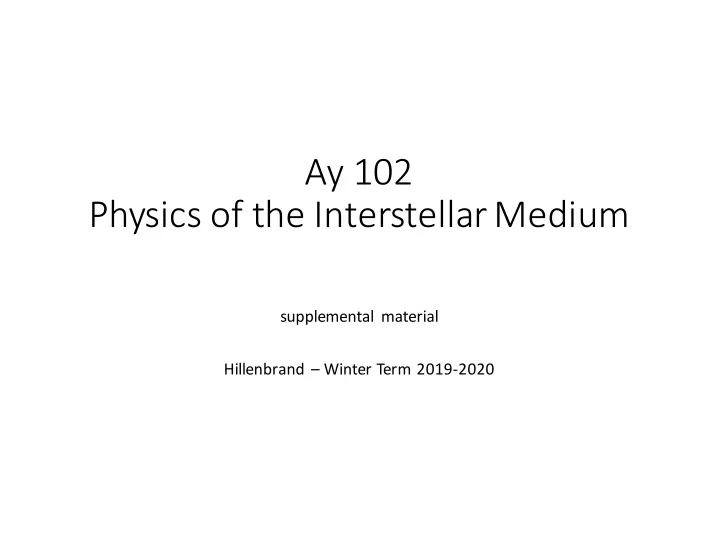

Ay 102 Physics of the Interstellar Medium supplemental material Hillenbrand – Winter Term 2019-2020
The Dynamic ISM
The Dynamic ISM What happens when flow velocities exceed the local “pattern speed”? https://www.youtube.com/watch?v=Suugn-p5C1M&NR=1&feature=fvwp https://www.youtube.com/watch?v=Q78Kb4uLAdA
The Dynamic ISM Earth B-field vs Solar wind Shocks are everywhere, occurring on all astrophysical scales. Solar wind vs local ISM NASA/IBEX
The Dynamic ISM Jets from Young Stars Stellar Winds Russell CromanAstrophotography
The Dynamic ISM Supernova Remnant Guitar Nebula: pulsar moving @2000 km/s! Red = x-ray Green = forbidden optical line High velocity “black widow” pulsar charge exchange
The Dynamic ISM Cloud-Cloud Collisions HII Regions
The Dynamic ISM Galactic Spiral Density Waves
The Dynamic ISM The Antennae Galaxies Collision of gas leads to shocks - > star formation
Dynamics Nomenclature Mach number, M = v / c s • v >> cs è strong shock • v ≥ cs è weak/mild shock • v < cs è no shock
Dynamics – Getting to the Math Adopt a frame in which the shock is stationary. Cold ”pre-shock” / “upstream” gas moves into the shock at high velocity. Hot “post-shock” / “downstream” gas moves away with |v 2 | < |v 1 | . Consider shock to be plane-parallel, such that properties of the fluid depend only on the linear distance, x, and all v’s are v x . Neglect viscosity except in the shock transition zone, Δ x, where large dv/dx means kinetic energy transformed into heat (viscous dissipation). Δ x Δ x è 0 is a discontinuity or “jump”. Maoz
Dynamics – Getting to the Math (note: opposite orientation from previous slide) Arce “upstream” “downstream” Radiative shock : cools by emitting radiation - more efficiently than via adiabatic cooling v ~ 10’s to 100’s of km/s n ~ 104 – 105 cm-3 Non-radiative shock : cools adiabatically, by expansion - more efficiently than by emitting radiation v ~ 1000 - 104 km/s n ~ 103 – 104 cm-3
Dynamics – The Math “upstream” “downstream” Conserve mass Conserve momentum Conserve Energy
Non-Radiative Shocks - Do not Cool Efficiently ✗ ✗ case of Δ x ~ few mean free paths, i.e a • transition zone è continuous shock P2 case of è jump shock “continuous” • u1 ρ 2 velocity P2 u1 velocity ρ 2 ρ 1 u2 density P1 “jump” pressure ρ 1 density u2 P1 pressure Shu
Non-Radiative Shocks – Do not Cool Efficiently (to the right, pay attention to the axis notation - velocity decreases after the shock, but is plotted as u1/u2 instead of u2/u1 like the other quantities.) Shu/ Goodman
Non-Radiative Shocks – Do not Cool Efficiently Note: • Shocks are irreversible processes. • Thus, entropy is not in fact conserved. • Hence, the truly adiabatic, non-radiative case is fictitious. • A more appropriate term is “viscous shock” with viscosity ν ~ l * v shock • These are usually M1 >> 1 circumstances with high v shock and low ρ .
Radiative Shocks – Cool Efficiently L = L ( ρ , T) = Λ – Γ “net cooling function” Shu
Radiative Shocks – Special Case of “Isothermal” misnomer, since during the passage of shock, T does increase! NOTE: notation here uses only 1 è 2 whereas previous slides had 1 è 2 compression/heating and then cooling è 3 ??? via Goodman
Radiative Shocks - Special Case of “Isothermal” misnomer, since during the passage of shock, T does increase! Cs = 2 Cs C s (to the right, pay attention to the axis notation - velocity decreases after the shock, but is plotted as u1/u3 instead of u3/u1 like the other quantities.) Shu/ Goodman
Shock Nomenclature • J-shock (“jump” in conditions across shock boundary) • C-shock (“continuous” change) • Radiative è can be considered J-shock especially if Δx size scale over which the Δu deceleration occurs is very small. • Non-radiative è can be J-shock or C-shock. • MHD shock è always C-shock.
More Realistic (Non-Cartoon) Models (MHD case)
“upstream” “downstream” Radiation from Shocked Hot Gas Ho Different emission lines are seen as a function of position along the shock direction, depending on the density and temperature of the gas. Dopita & Sutherland
Radiation from Shocked Ho Hot Gas “upstream” “downstream” Note the high ionization species near the shock front. Dopita & Sutherland
Radiative Processes “downstream” “upstream” for Shocked Co Cold Gas Note that the status of the dust must be considered, in addition to the gas, for overall cooling function.
Recommend
More recommend